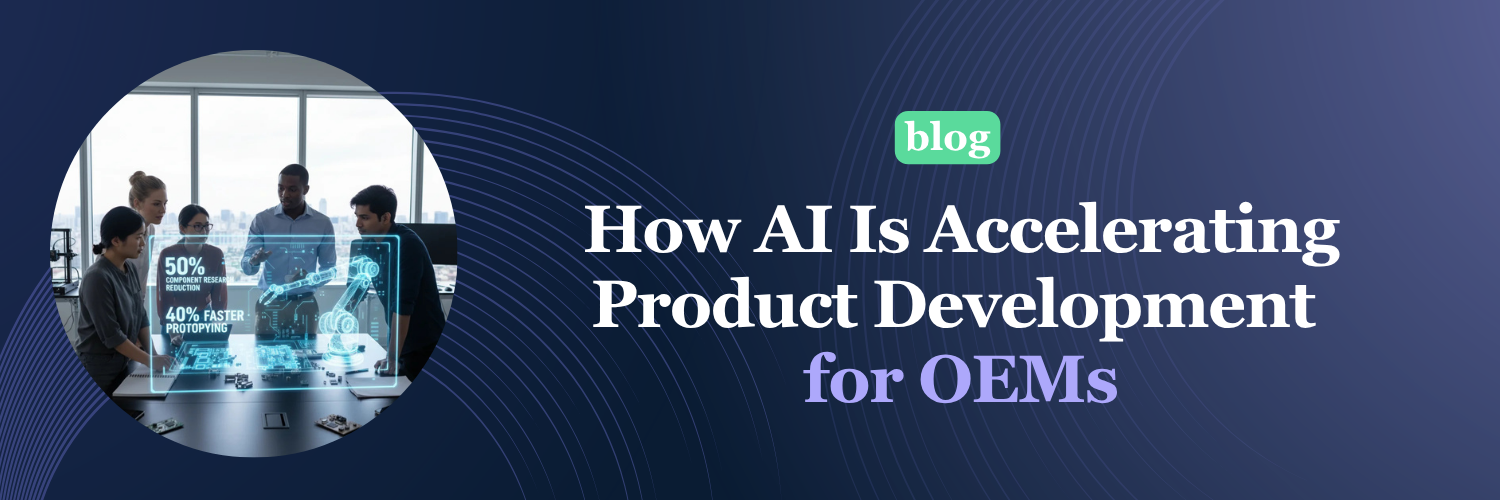How AI Is Accelerating Product Development for OEMs

If you're managing product development at an OEM right now, you already know the pressure: every product launch is a race. Your competitors are moving fast. Your customers expect innovation. And every delay—whether it's in prototyping, component validation, or supplier sourcing—puts your timeline and budget at risk.
Here's the frustrating part: a lot of those delays aren't even about the hard engineering work. They're about the back-and-forth between teams.
Your design engineers pick components based on specs and performance. Then they hand things off to procurement, who has to figure out if those parts are actually available, how much they'll cost at volume, and whether they're compliant. By the time that information gets back to engineering, the timeline has already slipped.
Rinse and repeat. Iteration cycles stretch out. Redesigns pile up. Production ramps get pushed back.
But some OEMs have found a way to break this cycle. They're using AI to connect design decisions with real-time supply chain intelligence—and it's transforming how fast they can move from concept to production.
Companies using Breadboard are seeing component research time cut in half, development cycles accelerate by 40%, and component costs drop by 3–5%. Not through shortcuts or compromises—through smarter workflows.
The Hidden Time Sink: Component Research
It's kind of ironic. The electronics industry is all about innovation and speed, but one of the biggest things slowing everyone down is... looking up parts.
Design engineers can spend hours, sometimes entire days, just trying to validate whether a component is available, what its lifecycle status is, and if it meets compliance requirements. And until they have those answers, they can't really move forward with confidence.
This constant back-and-forth with procurement creates a bottleneck that affects everything downstream.
Breadboard flips this around by putting supply chain intelligence directly into the design workflow. Instead of engineers having to stop and wait for answers, they get the information they need instantly.
Here's what that looks like in practice:
50% less time spent on component research. Engineers aren't stuck waiting—they can validate parts in seconds and keep designing.
Faster prototype builds. When you know immediately what's available, you can start building instead of planning and replanning.
Fewer design iterations. Catching sourcing constraints early means you're not discovering problems after you've already committed to a design.
Synchronized timelines. When design and supply chain are working from the same real-time data, everything moves faster.
What used to require a formal procurement request now happens while the engineer is still thinking through their design. That kind of speed changes everything.
Cutting Costs Without the Usual Trade-offs
Every OEM lives in this tension: you want to reduce component costs, but you can't afford to compromise on quality or create supply chain fragility.
Traditionally, those things felt mutually exclusive. Cheaper parts often meant taking risks you didn't want to take.
AI sourcing changes that equation. Breadboard's platform finds 3–5% in cost reductions across your product portfolio by spotting efficiencies that manual processes just miss.
Here's how:
Volume leverage across product lines. Instead of optimizing each product in isolation, the platform looks at your entire portfolio and finds opportunities to unlock better pricing tiers by aggregating demand.
Smarter supplier diversification. You get cost benefits without becoming overdependent on a single source—which is exactly what you need for resilience.
Lifecycle-informed decisions. The platform steers you away from parts that are likely to go end-of-life soon, which means fewer costly redesigns down the road.
The key is that AI can analyze the entire supplier ecosystem continuously. It's not about cutting corners—it's about finding the opportunities that are hiding in plain sight.
Building Supply Chains That Can Actually Handle Disruption
The last few years taught us all a hard lesson: if your supply chain isn't resilient, your whole product roadmap is at risk.
Semiconductor shortages. Geopolitical chaos. Factory shutdowns. Pick your crisis—they all had the same result: OEMs scrambling to redesign products or delay launches because critical components weren't available.
Now, the best OEMs aren't just designing for performance. They're designing for continuity.
Breadboard helps you build supply chains that can adapt when things go sideways. The AI continuously monitors supplier performance and part lifecycles, so if a risk is emerging, you get early warning—and you get pre-qualified alternatives before production is actually affected.
What that means in practice:
Predictive risk monitoring. You're not reacting to problems after they hit. You're getting ahead of them.
Multi-source strategies for critical parts. You're not dependent on a single supplier for the components that matter most.
Automated alternative qualification. When you need a backup option, the platform has already done the homework.
Early alerts on end-of-life and availability issues. You have time to plan, not just time to panic.
When disruption happens (and it will), OEMs using Breadboard recover faster—sometimes before their competitors even realize there's a problem.
From Prototype to Production Without the Usual Chaos
Scaling from prototype to production is where a lot of product launches stumble.
Suddenly you're dealing with inconsistent supplier data, unclear pricing at higher volumes, and a bunch of disconnected tools that don't talk to each other. Engineering's component data doesn't match what procurement is working with. Nobody's quite sure what the actual cost will be at production volumes.
Breadboard gives you unified visibility across the entire product lifecycle. The same component intelligence that helps your engineers make design decisions extends seamlessly into manufacturing. As quantities scale, pricing adjusts automatically, and you maintain continuity instead of dealing with handoffs and errors between teams.
Key capabilities:
Volume-tiered pricing automatically applied. You're not manually recalculating costs as production scales up—the platform does it.
Supplier capability mapping. You know which suppliers can actually handle production volumes before you commit.
Demand forecasting. Procurement can plan ahead instead of constantly playing catch-up.
Broker and distributor network integration. When you need components fast, you have options.
One source of truth. No more version control nightmares. No more "wait, which spreadsheet has the latest pricing?"
Staying Ahead of Component Obsolescence
Here's a problem that doesn't get enough attention: your product might ship successfully today, but what happens in two years when a critical component goes end-of-life?
Component lifecycles don't pause just because your product is out in the market. And for OEMs, especially those with longer product lifecycles, obsolescence isn't a minor inconvenience—it's a strategic risk.
Breadboard's AI continuously monitors your active components for end-of-life trends, pricing shifts, and supply risks. When something changes, you get migration timelines and qualified alternatives with enough lead time to actually do something about it.
Features include:
Automated obsolescence monitoring. You're not manually tracking hundreds of components across multiple products.
Predictive end-of-life warnings. You get advance notice, not last-minute surprises.
Alternative qualification with side-by-side comparison. When you need a replacement, you can evaluate options properly.
Last-time-buy optimization. Based on demand forecasts, you know exactly how much to buy before a part disappears.
This turns lifecycle management from a reactive scramble into something you can actually plan for.
Complete Supply Chain Intelligence (Not Just First-Tier Visibility)
Most OEMs have some visibility into their first-tier suppliers. But that's where it usually ends. You don't really know what's happening further down the chain, which means you're flying blind on a lot of risk factors.
Breadboard extends visibility across the entire supplier ecosystem. You get a panoramic view of sourcing performance, pricing trends, and compliance—not just from your direct suppliers, but across distributors, brokers, and manufacturers.
What that gives you:
Multi-tier supplier visibility. You can see beyond your immediate suppliers to understand the full picture.
Real-time market pricing intelligence. You know what components actually cost right now, not what they cost last quarter.
Compliance tracking for ITAR, RoHS, REACH. You're not manually chasing down compliance documentation.
Supply risk assessments with alternatives. When risks emerge, you have options ready to go.
This isn't just data for data's sake. It's actionable intelligence that helps you make better engineering decisions, smarter sourcing choices, and stronger supplier partnerships.
The Bottom Line
In today's electronics market, speed wins. But not reckless speed—intelligent speed.
The OEMs that are pulling ahead aren't necessarily the ones with the biggest teams or the most resources. They're the ones with the smartest workflows. The ones who've connected design and supply chain so they're not constantly tripping over internal handoffs.
Breadboard delivers measurable results: 50% reduction in component research time, 40% faster development cycles, and up to 5% lower component costs—all while reducing risk and building more resilient supply chains.
If you're tired of watching timelines slip because of supply chain friction, it might be time to rethink how your teams work together.
Ready to accelerate your next product launch?
Learn more about Breadboard for OEMs ➜



